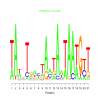Module 111 Residual: 0.18
| Title | Model version | Residual | Score |
|---|---|---|---|
| bicluster_0111 | v02 | 0.18 | -12.87 |
Displaying 1 - 21 of 21
| Cre02.g080250.t1.2 YGGT family protein | Cre03.g145967.t1.1 Nucleic acid-binding, OB-fold-like protein |
| Cre03.g148000.t1.2 | Cre03.g175200.t1.2 translocon at the outer envelope membrane of chloroplasts 75-III |
| Cre03.g201750.t1.2 | Cre07.g341850.t1.2 Translation initiation factor 2, small GTP-binding protein |
| Cre07.g352300.t1.2 | Cre08.g380201.t1.1 dehydroquinate dehydratase, putative / shikimate dehydrogenase, putative |
| Cre09.g386200.t1.1 | Cre12.g483550.t1.2 beta vacuolar processing enzyme |
| Cre12.g507150.t1.2 | Cre12.g517900.t1.1 Albino or Glassy Yellow 1 |
| Cre12.g527550.t1.2 | Cre12.g556150.t1.2 CAAX amino terminal protease family protein |
| Cre13.g566250.t1.2 | Cre13.g569250.t1.2 Predicted protein |
| Cre13.g576650.t1.2 histidine biosynthesis bifunctional protein (HISIE) | Cre14.g626350.t1.2 |
| Cre16.g673617.t1.1 Peptide chain release factor 1 | Cre17.g734300.t2.1 translocon outer complex protein 120 |
| Cre17.g746547.t1.1 Basic-leucine zipper (bZIP) transcription factor family protein |
|
e.value: 0.005 Motif Bicluster: Width: 21 Number of Sites: 1 Consensus: TAanTgactAatAaTAAtGtT |
motif_0111_2Submitted by Anonymous (not verified) on Wed, 05/20/2015 - 14:16e.value: 0.000062 Motif Bicluster: Width: 15 Number of Sites: 1 Consensus: GCTcctGCTgCtGCT |
Displaying 1 - 1 of 1
| Interaction | Weight | |
|---|---|---|
Displaying 1 - 1 of 1
| GO Terms | Descriptions |
|---|---|
| GO:0004635 | phosphoribosyl-AMP cyclohydrolase activi... |




Comments